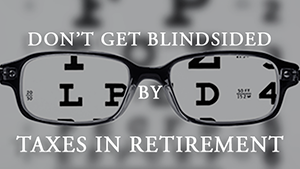
By David Brooks, Founder & President of Retire SMART
When people think of expenses in retirement, they tend to think of housing and health care. Those certainly are two major budget items in any retirement plan. But a successful retirement plan also accounts for the other major expense in retirement: taxes.
We tend to think of taxes as something that bedevils us during our working years. For most of us, the biggest tax we pay is on income. We have it deducted from our paychecks, so we haven’t put a lot of thought into how to most efficiently pay our taxes. We cruise into retirement thinking: “I’m not working and earning income anymore, so I don’t have to worry about taxes.”
That is a dangerous trap.

This is especially true if most of your retirement funding is in a traditional IRA or 401(k). You were able to defer the tax bite when you contributed to those accounts, but the word is “defer,” not “avoid;” you will pay taxes on that money. Uncle Sam gives you that tax break on the front end of the transaction because he knows he will get even more tax revenue on the backside of the transaction.
To make sure of that, the IRS requires you to take required minimum distributions when you reach certain age thresholds, generally in your early 70s. Those RMDs are subject to taxes. That’s where Uncle Sam gets his piece of the action on those “tax-free” contributions you made to the account upfront.
Retirees often are blindsided by the fact that an RMD can push them into a higher tax bracket than the one they were in during their working years. This is sometimes called a “cliff.” It’s not a cliff from which you fall; it’s a steep wall of tax burden suddenly placed in your path that you must climb when you withdraw those RMDs. Someone who was in the 12% federal income tax bracket in his working years might suddenly find himself in the next bracket – 22% – in retirement. That’s an 83% increase!

There’s another common pitfall. It’s often called the “widow’s tax” or “widow’s penalty” because it falls on the surviving spouse, which usually is the wife. After the death of her husband, the wife may receive the same income, or perhaps somewhat less, yet find herself facing that tax cliff described above because of her new status as a single filer, which vaults her into a higher tax bracket.
These are two examples of numerous ways your tax burden can change in retirement. The good news is, there are ways to mitigate or eliminate the impact of these taxes. At Retire SMART, we have dozens of such strategies. But timing is crucial. Some strategies must be implemented at specific times. Others take several years to ripen and provide the desired benefit.
Don’t wait. Consult a professional financial advisor immediately to best position yourself for the changes to your tax burden that happen in retirement.

